Abstract
A field study of thermal comfort in a design classroom for teaching architecture and dormitory rooms in a cold area of China was conducted to provide a better understanding of the thermal comfort of students, and to clarify the energy saving potential of such building spaces. Respondents were the same for both the classroom and dormitories field survey, with a total of 89 students majoring in architecture. The students’ subjective thermal responses and their environmental parameters for two months before and after heating were collected and compared, and the results showed that when respondents adjusted their clothing it was not necessarily to adapt to the thermal environment but may have been due to habituation. The thermal neutral operative temperature was determined to be 23.1 °C in the design classroom and the thermal sensation was maintained at neutral-cool in the dormitory rooms. Although there were significant differences between the thermal environments in the classroom and dormitories, thermal acceptability was close to 100%. In the design classroom, the PMV (Predicted Mean Vote) predicted the indoor thermal environment relatively accurately, while in dormitory rooms, the PMV underestimated the thermal sensations. Students can tolerate lower temperatures, showing adaptability to the environment.
1. Introduction
Education buildings are the main places for teachers and students to study, work and live. The indoor air quality is directly related to the thermal comfort, health and learning efficiency of students and teachers [1,2,3,4]. In order to create a comfortable working and learning environment, HVAC (Heating, Ventilating and Air Conditioning) is widely used, so energy consumption is an important issue to be concerned about [5]. At present, uncertainties in international energy security are increasing, energy prices are soaring, and energy conservation is imminent. Moreover, under the background of carbon peak in 2030 and carbon neutrality in 2060 proposed by the Chinese government, it is an obligation to reduce energy consumption on the premise of meeting thermal comfort.
1.1. Thermal Comfort in University Classrooms
A literature survey has showed that with different groups of students at different stages, such as kindergarten, middle school and university, due to different learning tasks, different ages, different cognitive and other reasons, there must be certain differences in the thermal comfort requirements in the classroom [6]. For university classrooms, due to climate differences, there are some differences in students’ preference for environmental temperature and the highest acceptable temperature [7]. Moreover, different nationalities have certain differences in thermal comfort temperature and thermal adaptation behavior [8], and different adaptation models will affect students’ thermal comfort perception and thermal adaptation [4].
In order to clarify the above points, researchers have carried out extensive field studies. A field survey of naturally ventilated and free-running classrooms was carried out and found that the indoor thermal environment of classrooms and the thermal neutral temperature of students differed according to the seasons; the indoor environment was affected by the outdoor climate, and the outdoor climate showed obvious seasonal differences, and there was a significant difference between actual thermal sensation and PMV [9,10,11,12]. Students in cold climate areas had a certain degree of climate adaptability to the cold environment [13]. On the contrary, students in hot climate areas had a higher tolerance to the hot environment, and psychological adaptation played an important role [14].
In order to cope with the hot climate in summer, air conditioning is a widely used indoor temperature adjustment method. Fang [15] investigated the thermal adaptation of students in air-conditioned classrooms in hot and humid areas of China. Clothing adjustment was the main adaptation method. When the indoor operative temperature was lower than 27 °C, the PMV underestimated the actual thermal sensation of the respondents. The literature [16] showed similar findings. However, some authors in the literature also reported that PMV can accurately predict thermal sensation in air-conditioned classrooms [17].
In order to cope with severe cold and cold climate in winter, central heating and air conditioning are the most important indoor environment adjustment methods. Cao [13] conducted a field survey of ordinary university classrooms in severe cold areas, cold areas, hot summer and cold winter areas in China, and found that the classrooms in Harbin were overheated, and people were accustomed to a warmer indoor climate, while students in Shanghai had a certain adaptability to the cold environment. However, during the heating period in other cold climate zones, the survey found that students showed a preference for cold environments, and PMV overestimated students’ thermal sensation [18].
The above literature studies show that there are some differences in indoor environment and thermal comfort in different climate zones and different models of university classrooms. Moreover, the PMV model cannot be used to evaluate the thermal environment. So far, no unified and executable thermal comfort evaluation standard has been developed.
1.2. Thermal Comfort in University Special Buildings
In addition to field studies of university classrooms, there have also been investigations into education buildings with special functions. Ge [19] investigated the indoor heating and cooling behavior, as well as window opening and energy consumption, of a research building in Hangzhou located in a hot summer and cold winter zone for more than one year and developed an energy-saving design strategy based on the results of the field study. Mishra [20] investigated thermal comfort in a naturally ventilated undergraduate laboratory in a tropical climate and assessed students’ ability to perceive the thermal environment while carrying out their normally scheduled tasks. The survey results showed that the comfort temperature values were related to the prevailing mean outdoor air temperature to give an adaptive comfort equation. Additionally, the occupants showed adaptability across a comfort zone that was well beyond the recommendations of rational models.
Some studies in the literature also compare thermal comfort between classrooms and offices, classrooms and laboratories, and classrooms and dormitories. For example, Wang [21] conducted a field study of classrooms and offices at a university in Harbin during winter. The mean air temperature in the classroom was 22.8 ± 1.32 °C, and the mean air temperature in the office was 25.4 ± 0.7 °C. The environment was comfortable and the neutral temperature was equal to the mean indoor air temperature. Hu [22] conducted a field study and found that there was a certain difference in the acceptable temperature range between the university classrooms and laboratories in hot summer and cold winter areas. The main reason was that the classroom was a naturally ventilated environment, while the laboratory was an air-conditioned environment, so the acceptable temperature range in the classroom was higher than that in the laboratory. During the heating season, Wang [23] conducted a field survey of university classrooms and dormitories in severe cold regions of China and found that compared to classrooms, students in dormitories had a higher neutral temperature, and clothing insulation in classrooms was higher than in dormitories. The respondents’ thermal responses were evidently discrepant in different built environments. The actual thermal sensation was higher than the PMV. Additionally, because of different behavioral adaptations, students also had different thermal responses to the indoor environment. The indoor environment and thermal comfort standards of buildings with different functions are also different.
1.3. Thermal Adaptation and Energy-Saving
The above-mentioned field surveys of education buildings confirmed the existence of thermal adaptation. The surveys conducted under different conditions, such as in varied locations and climatic conditions (hot and humid area, cold area, naturally ventilated building or a centralized heating building, or an air-conditioned building), verified the influence of thermal history on thermal sensation, the regulation of thermal adaptation behavior, and the existence of psychological adaptation. People and buildings are the two important aspects of thermal adaptation. Different groups of people and different buildings may cause differences in thermal adaptation, and thermal adaptation differences are important factors for thermal comfort and building energy efficiency [24].
1.4. Study Aim
The design classroom for architecture is a dedicated teaching and learning space for architecture students to study, design, and draw. Students study in it for a long time, they are relatively familiar with the classroom environment, and thermal adaptation is a relatively regular pattern, which is different from the ordinary classroom environment. Previous studies have mainly focused on the thermal comfort of students in ordinary classrooms, while less research has been carried out on thermal comfort in special classrooms. Previous studies have mainly focused on field surveys in short-lived classrooms, often for a short stay, to complete the questionnaires, and some for one class time; thermal adaptation may not be sufficient in these cases and time is also a main factor affecting thermal adaptation [25]. According to statistics, up to now, the number of colleges and universities offering architecture majors in mainland China is large, with a total of 308. It is of great practical significance to carry out research on the thermal comfort and energy-saving potential of design classrooms teaching architecture.
In order to clarify the energy-saving potential of this space, the thermal comfort of the same respondents in dormitory rooms was also conducted and compared. This is also the main innovation of this paper. In previous thermal adaptation research, the PMV model was directly compared with the field results of buildings in various places, but there are differences between humans and the environment; the adaptation effects of behavior, physiology and psychology are combined and the role of a single adaptive factor cannot be revealed. The respondents are the same, and the survey results more truly reflect the thermal adaptation differences between the two types of buildings, providing more realistic and effective scientific guidance for indoor environmental control and the energy saving potential of design classrooms for teaching architecture.
Overall, the aims of this study are to identify the thermal comfort and adaptation of the same respondents, provide a better understanding of the thermal perception of students, and provide a scientific basis for design classroom temperature control.
In order to achieve this goal, this paper mainly analyzes the results of the field study from the aspects of environmental parameters, psychological responses, thermal adaptation, and comparison with PMV to achieve the purpose of this study.
2. Methods
This field survey was carried out after the completion of preparatory work, and the results were obtained by sorting and analyzing the collected data. An outline of our methodology is presented in a flowchart in Figure 1.

Figure 1.
Outline of the methodology.
2.1. Location and Climate
The location of this study is Anyang City, Henan Province, China, which is located in a northern warm temperate zone with a continental monsoon climate, extremely cold in winter and hot in summer. The annual average temperature is 12.7–13.7 °C, the annual average relative humidity is 65–68%, and the outdoor annual average wind speed is 1.7–3.5 m/s. According to the dividing climate region for building thermal design [26], it is a cold climate zone (Figure 2). The central heating period is four months from 15 November to 15 March of the following year. Heating energy consumption is the most important building operation energy consumption.
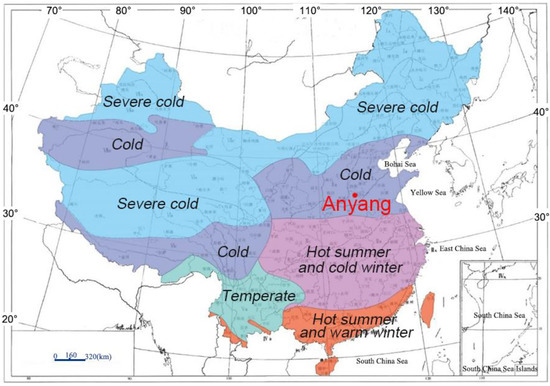
Figure 2.
Location of Anyang city.
2.2. Spaces
The field survey was conducted in the design classroom for architecture at the School of Civil and Architectural Engineering of Anyang Institute of Technology and the dormitory rooms where the respondents lived. An architectural plan is shown in Figure 3. The plan of all dormitory rooms are the same.

Figure 3.
Architectural plan of (a) design classroom, (b) dormitory room.
Classroom and dormitory rooms have openable windows, fans, split air-conditioner, and radiators provided by the municipal central heating. Their locations are shown in Figure 3. In summer, students can freely choose to use fans or air-conditioning to adjust the indoor temperature when needed. In winter, the radiator is operated by municipal heating, and the temperature cannot be adjusted. However, students can choose to use air-conditioning for indoor temperature adjustment when needed. The difference is that the electricity bill generated by the air-conditioner in the design classroom is paid for by the university, while the fee for the air-conditioner in the dormitory rooms is paid for by the students themselves.
2.3. Time of Survey
The survey period extended from 15 October to 31 December in 2020 for two months, before and after heating.
Field surveys of the design classroom were carried out during the architectural design class. The duration of the design class was one afternoon (4 h). Students were mainly engaged in light manual labor, such as literature reading and architectural drawing, which were accomplished by either sitting or standing. The questionnaire survey was conducted after two classes (2 h). By that time, the students had basically adapted to the thermal environment and the thermal environment and thermal response were both in a steady state. The field survey in the dormitory rooms was conducted in the evening after the students returned to the dormitory.
To accurately grasp the weekly thermal response and thermal adaptation information of the respondents and to avoid interference in the survey results due to inertia, overfamiliarity, or memory, etc., the classroom survey was conducted on the 2nd and 4th afternoons of each week, and the dormitory survey was conducted on the 1st, 3rd, and 5th nights of each week. In case of holidays, the survey was suspended.
2.4. Respondents
The respondents were sophomore and junior students majoring in architecture who had lived and studied in Anyang for at least one year. They had adapted to the local climate and were familiar with the design classroom and dormitory environment.
The respondents were close in age, with small differences in height, weight, and body mass index (BMI), and their daily schedules were consistent. The basic information of the respondents is shown in Table 1.

Table 1.
Basic information of the respondents.
2.5. Field Survey Methods
The field survey mainly adopted the Type II field survey method [27]. All the physical environment variables required to calculate the thermal comfort index SET (Standard Effective Temperature) and PMV (Predicted Mean Vote) were observed and measured and conducted simultaneously with the questionnaire survey.
2.5.1. Environmental Parameter Measurement
Thermal environment parameters mainly included air temperature (ta), globe temperature (tg), air velocity (v) and relative humidity (RH). The parameters of the instruments used are shown in Table 2 and all meet the range and accuracy specified by the ISO7726 standard [28]. The location of the measuring points was arranged according to ASHRAE 55 [29] and the instrument was placed near the respondent, away from obvious heat sources. If the respondent was sitting, it was arranged at a height of 0.6 m, and if the respondent was standing, it was arranged at a height of 1.1 m (Figure 4).

Table 2.
Instrument parameters.
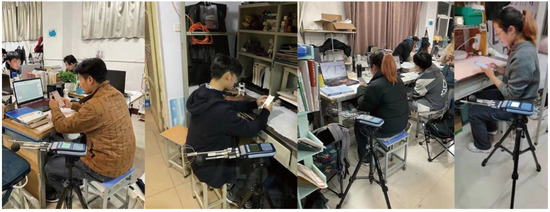
Figure 4.
Field survey.
Before the survey, the test instrument was switched on for about 20 min in advance and the questionnaire was started after the instrument was stable.
2.5.2. Questionnaire
Before the formal on-site thermal comfort survey was conducted, the personal information of the respondents, including gender, age, height, weight, native place, etc., were collected in advance.
The formal questionnaire mainly included (1) clothing, the activity status within the 20 min before the interview and during the interview; (2) psychological response: thermal sensation, thermal comfort, thermal acceptability, thermal and airflow preference, etc.; and (3) thermal adaptation behavior: whether to add or take off clothing after entering the room, the use of air conditioners, etc. The thermal sensation adopted a 7-point scale, including cold (−3), cool (−2), slightly cool (−1), neutral (0), slightly warm (+1), warm (+2), and hot (+3). Thermal comfort uses the 4-point scale proposed by Gagge, namely comfort (+1), slightly uncomfortable (+2), uncomfortable (+3), and very uncomfortable (+4). Additionally, the thermal acceptability scale recommended by Wyon et al., namely clearly unacceptable (−1), just unacceptable (−0.01), just acceptable (+0.01), and clearly acceptable (+1). Respondents made choices based on actual conditions. After the questionnaire was edited on the questionnaire star website (www.wjx.cn, accessed on 6 October 2020), the respondents scanned the QR code to fill it out.
This field study complied with the ethical code.
2.6. Data Process
Due to the low indoor air velocity (<0.2 m/s), according to ASHRAE standard 55 [25], the operative temperature (to) is approximately equal to the average value of the air temperature and the average radiation temperature, which is calculated using the following formula:
where to is the operative temperature, ta is air temperature, and tr is mean radiant temperature.
to = (ta + tr)/2
A total of 1040 groups of valid data were collected in this survey. To reduce the impact of a few extremes and to better represent the majority, the “bin” method was repeatedly used in this study, i.e., the data were divided into bins by operative temperature in 0.5 °C steps, the values of the variables were averaged for each bin, and the averages were analyzed by their weighted sample size. All the statistical analyses were performed using SPSS v 22.0 software (IBM, New York, NY, USA), and all the differences were accepted as significant at a 0.05 level.
The PMV value was calculated according to the formula given in ISO7730 [30]. The clothing insulation was assigned to each item of clothing according to ISO7730 [29], the total thermal insulation was then calculated by summing up the insulations of the clothing. Because the students in the classroom and dormitory used a stool, the additional thermal insulation was not considered.
3. Results and Discussion
3.1. Thermal Environment
During the survey period, the average outdoor air temperature showed a downward trend, especially after November 17. When the temperature dropped significantly, central heating had already started (Figure 5). There were significant differences between the classroom and dormitory indoor air temperature, as estimated by an independent sample t test (p < 0.001). Compared to the dormitory rooms, the air temperature in the classroom fluctuated less during the entire survey period (22.0 ± 1.6 °C), and there was no obvious seasonal feature. The air temperature in the dormitory rooms showed a downward trend with a decrease in the outdoor air temperature and the difference in the air temperature between in the classroom and the dormitory rooms was greater in the later stage of the survey.

Figure 5.
Average indoor and outdoor air temperature during the survey period.
The relative humidity of the air in the classroom and dormitory rooms during the survey period is shown in Figure 6. The relative humidity in the classroom was mainly distributed between 20 and 50%, accounting for 63%. The relative humidity in the dormitory rooms was mainly distributed in 35–65%, accounting for 79%. The larger classroom accounted for lower relative humidity in the classroom than in the dormitory rooms. The air velocity in the classroom and dormitory rooms was relatively small (<0.2 m/s).
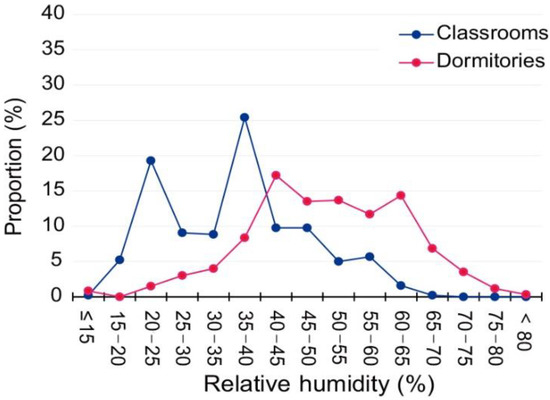
Figure 6.
Relative humidity distribution during the survey period.
With the passage of time, the difference in indoor air temperature between the design classroom and dormitory rooms increased considerably. The was possibly due to seasonal reasons. From autumn to winter, the outdoor temperature becomes lower and lower, which leads to a decrease in indoor temperature. Although it is also heating, the performance of the building envelope, heating pipes, radiators and so on affect the heating effect, resulting in differences in indoor air temperature. According to the literature [23], the air temperature in the classroom is also higher than that in the dormitory during the heating season. It is also a teaching building and a heating building, but the average indoor temperature in Harbin is higher than that in Beijing [13].
In addition, the split air-conditioners in the design classroom were turned on for a long time, whereas the split air-conditioners in the dormitory rooms were rarely turned on. More than 94% of the air-conditioning in the dormitory rooms was not used, which may be attributed to the fee mechanism for air-conditioning. The research of Chen and Huang [31] confirmed that the charging mechanism is an effective way to improve students’ higher threshold temperature and save energy.
It may also be because the field survey in the design classroom was carried out in the afternoon when the outdoor temperature is high, while the field survey in the dormitory room was carried out in the evening when the outdoor temperature is low, eventually leading to the obvious seasonal characteristics of the indoor climate of the dormitory rooms, which is more affected by the outdoor climate.
In addition, due to the influence of human respiration and heat dissipation, there are more people in the design classrooms than in the dormitory rooms, which may also be the reason for the large difference in indoor temperature between the two types of spaces.
3.2. Clothing Insulation and Adjustment
3.2.1. Clothing Insulation
In autumn and winter, the outdoor climate is colder and students wear thicker clothes to resist the cold. The relationship between clothing insulation and operative temperature is shown in Figure 7. There is a negative correlation between clothing insulation and operative temperature, and clothing insulation decreases with increasing operative temperature. Under the same temperature conditions, the clothing insulation in the dormitory rooms is lower than that in the design classroom. The higher the temperature, the smaller the difference.
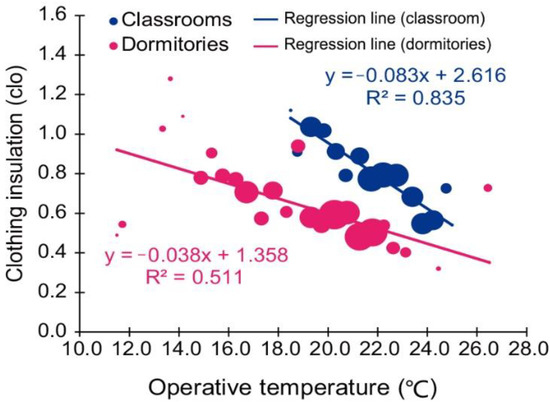
Figure 7.
Clothing insulation changes with operative temperature.
3.2.2. Clothing Adjustment
The frequency of clothing adjustments performed by the students when they returned to the room is shown as Figure 8. Most of the time, clothing was reduced, the proportions are 36.1% in design classroom and 67% in dormitory rooms, respectively. The proportion of adding clothes is very small. The reason distribution for reducing clothes is shown as Figure 9: 67.4% of the adjustments in the classroom were caused by the students feeling warm, while only 29% of the students in the dormitory rooms adjusted their clothing because of the warm temperature, and 71% of the students reduced their clothing out of habit.
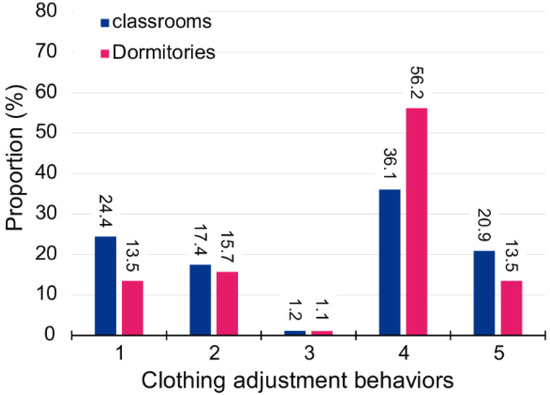
Figure 8.
The frequency of clothing adjustments performed by the students. 1: no; 2: most of the time no; 3 add most of the time; 4: reduce most of the time; 5: Occasionally add or reduce.

Figure 9.
The reason distribution of reduce clothes.
In the dormitory rooms, the proportion of those taking off their coat is higher and it was not a thermal regulation behavior due to feeling warm. According to the survey, in the classroom, undressing is more of a thermal adaptation behavior for feeling warm. In the dormitory, only 29% of the students took off their clothes for thermal adjustment because they felt warm, and 71% of the students undressed because of habituation (as shown in Figure 9), that is, not for the main purpose of adapting to the climate. Therefore, with respect to clothing adjustment as the freest manner of adaptation, adaptation is not necessarily its main purpose, and habit is also an important factor for us to consider.
The results of the field survey show that under the same thermal environment, the clothing insulation in the classroom is larger than that in the dormitory. In the low temperature range, the main reason for the large difference in clothing insulation was that clothing was based on the outdoor climate [32]. A colder outdoor temperature resulted in thicker coats and greater clothing insulation, which led to a greater difference in clothing insulation after the coat was taken off.
This was similar to Wang’s results [23]; that is, the clothing insulation in the classroom is larger than that in the dormitory, but they were not exactly the same. Wang’s field survey showed that the lower the temperature, the smaller the difference in clothing insulation between them. A possible reason was that the climate zone was different in Wang’s field survey. More clothes were needed to keep warm because of outdoor climate conditions.
3.3. Thermal Responses
3.3.1. Thermal Sensation
The relationship between thermal sensation and operative temperature is shown in Figure 10. The thermal sensation of the students in the classroom has a strong linear relationship with the operative temperature, and the thermal sensation increases as the operative temperature rises. The linear relationship between thermal sensation and operative temperature in the dormitory rooms is weak. Thermal sensitivity, namely, the slope of the regression line, is poor, and thermal sensation is maintained in the neutral to cold (0–1) range.
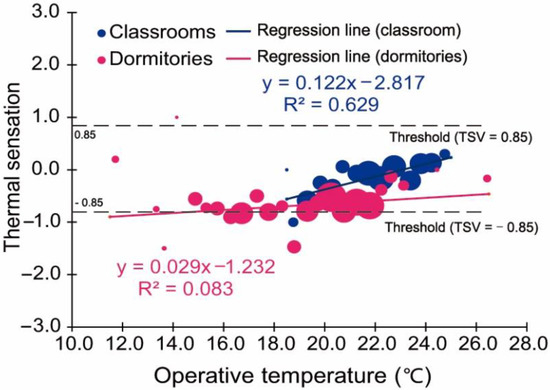
Figure 10.
The relationship between thermal sensation votes and operative temperature.
According to the regression formula, the neutral operative temperature of the respondents in the classroom is 23.1 °C, and the neutral temperature of the dormitory room is higher than the indoor operative temperature. The lower limit of the indoor operative temperature corresponding to the 80% satisfaction (TSV = −0.85) is 18.5 °C in the classroom and 13.2 °C in the dormitory. There is a big difference between the classroom and the dormitory room.
Under the same operative temperature condition, compared with the dormitory rooms, the thermal sensation of the respondents in the design classroom is higher, which may be related to the clothing insulation. It can be seen from Figure 7 that under the same temperature conditions, the clothing insulation in the design classroom was higher than that in the dormitory rooms.
3.3.2. Thermal Comfort
Figure 11 shows the percentage of respondents directly voting on thermal comfort in the design classroom and dormitory rooms. The percentage of thermal comfort votes in the classroom was approximately 61%, and that in the dormitory was approximately 57%. Uncomfortable and very uncomfortable votes accounted for small percentages, with a total of 1.8% in the classroom and 3.2% in dormitory rooms.
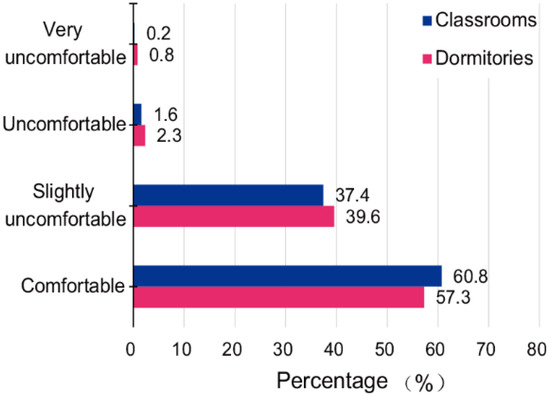
Figure 11.
Thermal comfort votes distribution.
A second-order polynomial function relating thermal comfort and thermal sensation was established for the students in the classroom and dormitory rooms, as shown in Figure 12. The regression formula was obtained as follows:
Classroom: y = 0.071x2 + 0.004x + 1.342 (R2 = 0.422)
Dormitory: y = 0.039x2 − 0.098x + 1.337 (R2 = 0.930)
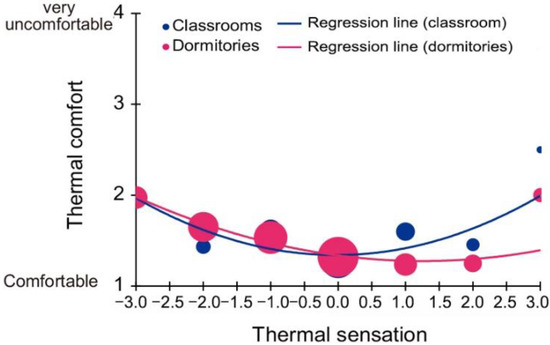
Figure 12.
The relationship between thermal comfort and thermal sensation.
When the respondents felt most comfortable, their thermal sensation voting was close to thermal neutrality, and when they were far from thermal neutrality, whether it was cold or hot, the discomfort increased. Their thermal comfort was similar on both the warm and cool sensation sides. On the warm sensation side, there was a certain difference in thermal comfort between the two groups. The warmer the thermal sensation, the more differences in thermal comfort.
3.3.3. Thermal Acceptability
The percentage of thermal unacceptability for different temperature ranges is shown in Figure 13. We can see that whether in classroom or dormitory rooms, the proportion of thermal unacceptability is less than 20%, and more than 80% of respondents accept the environment.
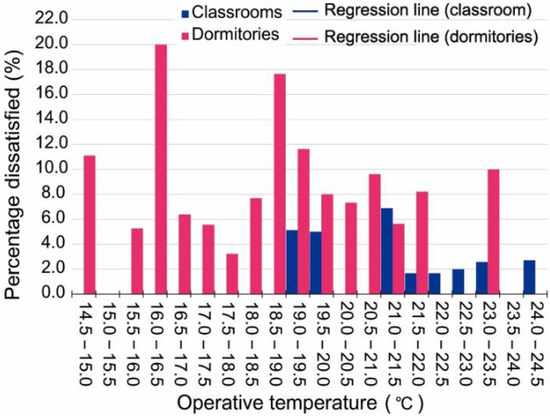
Figure 13.
Percentage dissatisfied with operative temperature.
Figure 14 shows the relationship between thermal acceptability and thermal sensation. There is a strong second-order polynomial relationship, and the regression formula is as follows:
Classroom: y = −0.032x2 + 0.082x + 0.442 (R2 = 0.565)
Dormitory: y = −0.017x2 + 0.089x + 0.454 (R2 = 0.978)
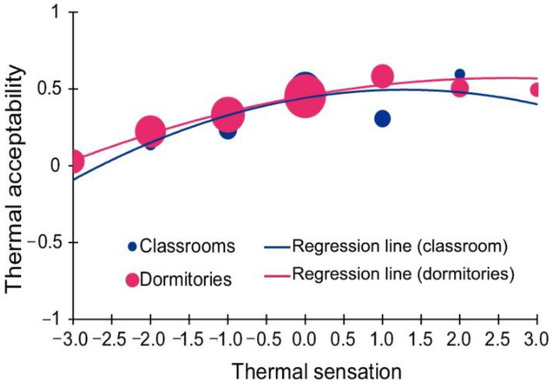
Figure 14.
The relationship between thermal acceptability and thermal sensation.
According to the formula, in the classroom, when the thermal sensation was 1.3, the thermal acceptability was the maximum; in the dormitory, when the thermal sensation was 2.6, the thermal acceptability was the maximum. Although there was a difference in the maximum value, it was acceptable regardless of the thermal sensation, which was consistent with the expression in Figure 13.
3.3.4. Thermal Preference
The voting percentage of the thermal and airflow preference is shown in Figure 15.

Figure 15.
The voting percentage of the thermal preference: (a) Thermal preference; (b) Airflow preference.
For thermal preference (as shown in Figure 15a), more than 70% of the respondents in the classroom did not want the indoor temperature to change, and 24% hoped to get warmer. Only a few students wanted to lower the indoor temperature. Furthermore, 55% of the respondents in the dormitory did not want changes in the room temperature, but a larger percentage (42%) of the respondents wanted the indoor temperature to rise, which corresponds to the cool thermal sensation of the respondents in the dormitory.
For airflow preference (as shown in Figure 15b), more than 66% of the respondents in the classroom did not want any changes in indoor airflow, and 30% wanted the airflow to be strong. Similarly, more than 72% of the respondents in the dormitory rooms did not want changes in indoor airflow, and 22% wanted the airflow to be strong.
To sum up, there is a significant difference in the thermal response of the respondents in the design classroom and dormitory rooms. From the perspective of thermal sensation, all the respondents in the classroom were in the 80% thermal satisfaction range, while most of the respondents in dormitory rooms were in the 80% thermal satisfaction range. From 80% of the thermal acceptable range, students in both classroom and dormitory rooms accepted the environment. There is a difference between thermal sensation and thermal acceptability. In the dormitory rooms, because of the adaptability of the respondents, they can tolerate lower temperatures, showing adaptability to the environment.
Judging from the respondents’ clothing insulation and thermal response in the design classroom and dormitory, psychological adaptation such as habits and expectations are the main influencing factors, and besides living habits, many background factors may affect thermal expectations and thermal responses. For example, time, because before going to bed, the respondents stay in the cooler environment for a short time, the clothing insulation is small, and the thermal comfort and thermal acceptability are high. However, whether it is sustainable remains to be investigated. According to the percentage of thermal unacceptability, if the temperature setting in the classroom is reduced to 18.5 °C on the existing basis, it will effectively reduce the use of energy, so as to achieve the purpose of saving energy, or adopt the same charging mechanism as the dormitory; it will also effectively reduce the frequency of air conditioning use, thereby reducing the energy consumption of air conditioning use and ultimately achieve the purpose of saving energy.
3.4. Comparison with the PMV
Using the methods in Section 2.6, the PMV values were obtained for each set of raw data, and the “bin” method was used to obtain the relationship between the PMV and the indoor operative temperature, as shown in Figure 16. The results of the thermal sensation votes are also shown.

Figure 16.
Comparison of PMV and TSV: (a) Classroom; (b) Dormitory.
A good relationship between the actual thermal sensation of the students in the design classroom and the PMV against the operative temperature under the same conditions was identified (Figure 16a). The thermal sensation increases with the increase in operative temperature. The thermal sensitivities, namely, the slope of the regression line were 0.122 °C−1 and 0.121 °C−1, respectively, and there was no significant difference (analysis of covariance, p = 0.749) between them. The actual thermal sensation is higher than the PMV, that is, the actual thermal sensation is warmer, and there is a significant difference between the actual thermal sensation and PMV (analysis of covariance, p < 0.001), and the latter is 0.2 units lower than the former.
Figure 16b shows the relationship between the actual thermal sensation of students in the dormitory rooms and the PMV against the operative temperature under the same conditions. A good linear relationship between the PMV and the operative temperature was identified. The PMV increases with the increase in the operative temperature, but there is a significant difference from the actual thermal sensation; this difference increases with a decrease in operative temperature.
The thermal environment in the classroom is relatively stable, and PMV can predict the indoor thermal environment relatively accurately. Similar to reference [17], the results for dormitory rooms are consistent with most studies in naturally ventilated buildings [14,33,34,35,36,37]; that is, the PMV underestimates the thermal sensation of the students in a cold environment, which may be related to adaptation and habits.
Previous studies postulated that the failure of PMV in accurately predicting thermal sensation in the field can be attributed to thermal adaptation [27,38,39]. Humans are no longer regarded as passive recipients of feelings but are in a dynamic equilibrium of active interaction with the thermal environment [38]. In other words, people are no longer passive recipients of a given environment, but active participants through multiple feedback loops [27]. In the dormitory rooms, because of the adaptability of the respondents, they can tolerate lower temperatures, showing adaptability to the environment.
3.5. Energy-Saving
According to the field survey results, the indoor air temperature of the dormitory is low. Although the heating quality has a certain impact on the indoor temperature, it obviously does not meet the minimum indoor requirement of 18 °C [40]. Therefore, from the perspective of energy saving, the building envelope and the thermal insulation performance of doors and windows need to be improved, and energy-saving retrofitting can be carried out at a later period. According to the results of the field investigation, if the indoor temperature in the design classroom is controlled within 18.5 °C, the energy consumption of air conditioning equipment can be greatly reduced and building energy saving can be realized.
In fact, building energy efficiency is affected by many factors, and the multi-objective decision model given by Diakaki [41] is a good method.
3.6. Limitation
Because the design classroom is used predominantly during the daytime and the use time of dormitory rooms is more at night, this can lead to a certain difference in the survey time. The research time difference between the design classroom and dormitory may also affect thermal sensation. Whether there were significant differences in thermal sensation in different periods of morning, noon and evening can be further explored in future studies.
Because the survey was conducted on thermal comfort in a design classroom, respondents were primarily limited to architecture students, resulting in a small sample size. In addition, whether or not reducing the indoor temperature of the classroom will affect learning, such as drawing, needs to be further studied.
4. Conclusions
A field study of thermal comfort in a design classroom for architecture and dormitory rooms was conducted. A total of 1040 sets of raw data that included both thermal environment parameters and respondents’ subjective responses were collected. The following conclusions were obtained by comparing:
- (1)
- The clothing insulation is negatively correlated with the operative temperature. With a higher the operative temperature, the clothing insulation becomes lesser. Clothing adjustment are not necessarily to adapt to the thermal environment, but may also be due to habit.
- (2)
- The thermal neutral operative temperature was determined to be 23.1 °C in the design classroom, and the thermal sensation is maintained at neutral cool in the dormitory rooms.
- (3)
- Although there are significant differences in the thermal environment between the design classroom and dormitory rooms, the thermal acceptability is indeed close to 100%. Respondents can tolerate lower temperatures, showing adaptability to the environment.
- (4)
- The thermal environment in the classroom is relatively stable and PMV can predict the indoor thermal environment relatively accurately. While in dormitory rooms, the PMV underestimates the thermal sensations.
According to the indoor operative temperature, thermal sensation, we can control the indoor temperature of the classroom to a comfortable boundary (18.5 ℃), limit the use of air conditioning, and exert people’s full potential to adapt to their thermal environment to achieve the goal of energy conservation.
This study identified the thermal comfort and adaptation of the same respondents to provide a better understanding of the thermal perception of students and provide a scientific basis for temperature control in a design classroom. Of course, in addition to thermal comfort, the building envelope and other factors affecting building energy efficiency should be reflected in the next study.
Author Contributions
Conceptualization, Z.Z. and Z.S.; Methodology, Q.L.; Investigation, T.Y.; Writing—Original Draft Preparation, Z.S.; Writing—Review and Editing, Z.Z. All authors have read and agreed to the published version of the manuscript.
Funding
This work was supported by The 13th Five-Year” National Key R&D Program of China [No. 2018YFC0704500].
Institutional Review Board Statement
Not applicable.
Informed Consent Statement
Informed consent was obtained from all subjects involved in the study.
Conflicts of Interest
The authors declare no conflict of interest.
References
- Jowkar, M.; Rijal, H.B.; Brusey, J.; Montazami, A.; Carlucci, S.; Lansdown, T.C. Comfort temperature and preferred adaptive behaviour in various classroom types in the UK higher learning environments. Energy Build. 2020, 211, 109814. [Google Scholar] [CrossRef]
- Lee, M.C.; Mui, K.W.; Wong, L.T.; Chan, W.Y.; Lee, E.W.M.; Cheung, C.T. Student learning performance and indoor environmental quality (IEQ) in air-conditioned university teaching rooms. Build. Environ. 2012, 49, 238–244. [Google Scholar] [CrossRef]
- Singh, M.K.; Ooka, R.; Rijal, H.B.; Kumar, S.; Kumar, A.; Mahapatra, S. Progress in thermal comfort studies in classrooms over last 50 years and way forward. Energy Build. 2019, 188–189, 149–174. [Google Scholar] [CrossRef]
- Lamberti, G.; Salvadori, G.; Leccese, F.; Fantozzi, F.; Bluyssen, P.M. Advancement on Thermal Comfort in Educational Buildings: Current Issues and Way Forward. Sustainability 2021, 13, 10315. [Google Scholar] [CrossRef]
- Barbhuiya, S.; Barbhuiya, S. Thermal comfort and energy consumption in a UK educational building. Build. Environ. 2013, 68, 1–11. [Google Scholar] [CrossRef]
- Jindal, A. Thermal comfort study in naturally ventilated school classrooms in composite climate of India. Build. Environ. 2018, 142, 34–46. [Google Scholar] [CrossRef]
- Jowkar, M.; Rijal, H.B.; Montazami, A.; Brusey, J.; Temeljotov-Salaj, A. The influence of acclimatization, age and gender-related differences on thermal perception in university buildings: Case studies in Scotland and England. Build. Environ. 2020, 179, 106933. [Google Scholar] [CrossRef]
- Zaki, S.A.; Damiati, S.A.; Rijal, H.B.; Hagishima, A.; Razak, A.A. Adaptive thermal comfort in university classrooms in Malaysia and Japan. Build. Environ. 2017, 122, 294–306. [Google Scholar] [CrossRef]
- Wang, X.; Yang, L.; Gao, S.; Zhao, S.; Zhai, Y. Thermal comfort in naturally ventilated university classrooms: A seasonal field study in Xi’an, China. Energy Build. 2021, 247, 111126. [Google Scholar] [CrossRef]
- Zhang, G.; Zheng, C.; Yang, W.; Zhang, Q.; Moschandreas, D.J. Thermal Comfort Investigation of Naturally Ventilated Classrooms in a Subtropical Region. Indoor Built Environ. 2007, 16, 148–158. [Google Scholar] [CrossRef]
- Nico, M.A.; Liuzzi, S.; Stefanizzi, P. Evaluation of thermal comfort in university classrooms through objective approach and subjective preference analysis. Appl. Ergon. 2015, 48, 111–120. [Google Scholar] [CrossRef] [PubMed]
- Jung, G.J.; Song, S.K.; Ahn, Y.C.; Oh, G.S.; Im, Y.B. Experimental research on thermal comfort in the university classroom of regular semesters in Korea. J. Mech. Sci. Technol. 2011, 25, 503–512. [Google Scholar] [CrossRef]
- Cao, B.; Luo, M.; Li, M.; Zhu, Y. Too cold or too warm? A winter thermal comfort study in different climate zones in China. Energy Build. 2016, 133, 469–477. [Google Scholar] [CrossRef]
- Yao, R.; Liu, J.; Li, B. Occupants’ adaptive responses and perception of thermal environment in naturally conditioned university classrooms. Appl. Energy 2010, 87, 1015–1022. [Google Scholar] [CrossRef]
- Fang, Z.; Zhang, S.; Cheng, Y.; Fong, A.M.L.; Oladokun, M.O.; Lin, Z.; Wu, X. Field study on adaptive thermal comfort in typical air conditioned classrooms. Build. Environ. 2018, 133, 73–82. [Google Scholar] [CrossRef] [Green Version]
- Balbis-Morejón, M.; Rey-Hernández, J.M.; Amaris-Castilla, C.; Velasco-Gomez, E.; San Jose-Alonso, J.F.; Rey-Martinez, F.J. Experimental Study and Analysis of Thermal Comfort in a University Campus Building in Tropical Climate. Sustainability 2020, 12, 8886. [Google Scholar] [CrossRef]
- Fabozzi, M.; Dama, A. Field study on thermal comfort in naturally ventilated and air-conditioned university classrooms. Indoor Built Environ. 2019, 29, 851–859. [Google Scholar] [CrossRef]
- Jing, S.; Lei, Y.; Wang, H.; Song, C.; Yan, X. Thermal comfort and energy-saving potential in university classrooms during the heating season. Energy Build. 2019, 202, 109390. [Google Scholar] [CrossRef]
- Ge, J.; Wu, J.; Chen, S.; Wu, J. Energy efficiency optimization strategies for university research buildings with hot summer and cold winter climate of China based on the adaptive thermal comfort. J. Build. Eng. 2018, 18, 321–330. [Google Scholar] [CrossRef]
- Mishra, A.K.; Ramgopal, M. Thermal comfort in undergraduate laboratories—A field study in Kharagpur, India. Build. Environ. 2014, 71, 223–232. [Google Scholar] [CrossRef]
- Wang, Z.; Li, A.; Ren, J.; He, Y. Thermal adaptation and thermal environment in university classrooms and offices in Harbin. Energy Build. 2014, 77, 192–196. [Google Scholar] [CrossRef]
- Hu, P.F.; Liu, W.; Jiang, Z.N. Study on indoor thermal senastion of youn college students in the area which is hot in summer and cold in winter. Int. J. Archit. Sci. 2006, 7, 47–52. [Google Scholar]
- Wang, Z.; Ning, H.; Zhang, X.; Ji, Y. Human thermal adaptation based on university students in China’s severe cold area. Sci. Technol. Built Environ. 2016, 23, 413–420. [Google Scholar] [CrossRef]
- Bae, C.; Chun, C. Research on seasonal indoor thermal environment and residents’ control behavior of cooling and heating systems in Korea. Build. Environ. 2009, 44, 2300–2307. [Google Scholar] [CrossRef]
- Nicol, J.F.; Humphreys, M.A. Adaptive thermal comfort and sustainable thermal standards for buildings. Energy Build. 2002, 34, 563–572. [Google Scholar] [CrossRef]
- The Ministry of Housing and Urban-Rural Development of the People’s Republic of China. Code for Thermal Design of Civil Building (GB 50176-2016); China Construction Industry Press: Beijing, China, 2016.
- Brager, G.S.; de Dear, J.D. Thermal adaptation in the built environment: A literature review. Energy Build. 1998, 27, 83–96. [Google Scholar] [CrossRef] [Green Version]
- ISO. Ergonomics of the Thermal Environment—Instruments for Measuring Physical Quantities; International Organization for Standardization: Geneva, Switzerland, 1998. [Google Scholar]
- ASHRAE Standard 55-2017; Thermal Environmental Conditions for Human Occupancy. ASHRAE: Atlanta, GA, USA, 2017.
- ISO. Ergonomics of the Thermal Environment e Analytical Determination and Interpretation of Thermal Comfort Using Calculation of the PMV and PPD Indices and Local Thermal Comfort Criteria; International Organization for Standardization: Geneva, Switzerland, 2005. [Google Scholar]
- Chen, C.P.; Hwang, R.L.; Shih, W.M. Effect of fee-for-service air-conditioning management in balancing thermal comfort and energy usage. Int. J. Biometeorol. 2014, 58, 1941–1950. [Google Scholar] [CrossRef]
- Fishman, D.S.; Pimbert, S.L. The thermal environment in offices. Energy Build. 1982, 5, 109–116. [Google Scholar] [CrossRef]
- Cao, B.; Zhu, Y.; Ouyang, Q.; Zhou, X.; Huang, L. Field study of human thermal comfort and thermal adaptability during the summer and winter in Beijing. Energy Build. 2011, 43, 1051–1056. [Google Scholar] [CrossRef]
- Kim, J.T.; Lim, J.H.; Cho, S.H.; Yun, G.Y. Development of the adaptive PMV model for improving prediction performances. Energy Build. 2015, 98, 100–105. [Google Scholar] [CrossRef]
- Ning, H.; Wang, Z.; Zhang, X.; Ji, Y. Adaptive thermal comfort in university dormitories in the severe cold area of China. Build. Environ. 2016, 99, 161–169. [Google Scholar] [CrossRef]
- De Dear, R.J.; Brager, G.S. Thermal comfort in naturally ventilated buildings: Revisions to ASHRAE Standard. Energy Build. 2002, 6, 549–561. [Google Scholar] [CrossRef] [Green Version]
- Zhang, N.; Cao, B.; Wang, Z.; Zhu, Y.; Lin, B. A comparison of winter indoor thermal environment and thermal comfort between regions in Europe, North America, and Asia. Build. Environ. 2017, 117, 208–217. [Google Scholar] [CrossRef]
- Humphreys, J.F. Understanding the adaptive approach to thermal comfort. ASHRAE Trans. 1998, 104, 991–1004. [Google Scholar]
- Fanger, P.O.; Toftum, J. Extension of the PMV model to non-air-conditioned buildings in warm climates. Energy Build. 2002, 34, 533–536. [Google Scholar] [CrossRef]
- The Ministry of Housing and Urban-Rural Development of the People’s Republic of China. Design Standard of Energy Efficiency of Public Buildings (GB 50189-2015); China Construction Industry Press: Beijing, China, 2015.
- Diakaki, C.; Grigoroudis, E.; Kabelis, N.; Kolokotsa, D.; Kalaitzakis, K.; Stavrakakis, G. A multi-objective decision model for the improvement of energy efficiency in buildings. Energy 2010, 35, 5483–5496. [Google Scholar] [CrossRef]
Publisher’s Note: MDPI stays neutral with regard to jurisdictional claims in published maps and institutional affiliations. |
© 2022 by the authors. Licensee MDPI, Basel, Switzerland. This article is an open access article distributed under the terms and conditions of the Creative Commons Attribution (CC BY) license (https://creativecommons.org/licenses/by/4.0/).